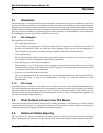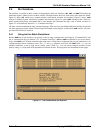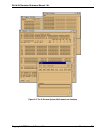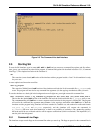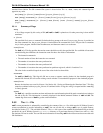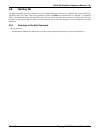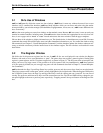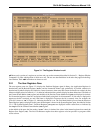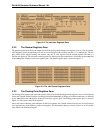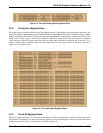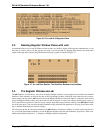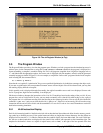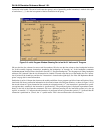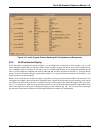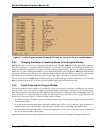
3-2 Screen Presentation Copyright © 2000 Hewlett-Packard Co.
Ski IA-64 Simulator Reference Manual 1.0L
ski
shows only a portion of a register set at a time and you use the commands described in Section 5.1, “Register Window
Commands” to select which portion of which set to see. The sets are described below in the order they appear in the Reg-
ister Window. Their
xski
realizations are shown as well.
3.2.1 The User Registers Pane
The user registers pane (see Figure 3-2) displays the Predicate Registers (prs) in binary, the Application Registers in
hexadecimal, and the Branch Registers (b0-b7) and the Instruction Pointer (ip) symbolically if possible, otherwise in
hexadecimal. Symbolic displays are limited to sixteen characters; when more than sixteen characters are needed, the first
fifteen are displayed and an asterisk (“*”) is added to indicate that the symbolic display has been abbreviated. The fields of
the Current Frame Marker (cfm) register and subfields of the Previous Frame Marker field (pfm) are displayed in decimal.
For bit-encoded registers, some bits are displayed individually using their IA-64 mnemonics. If a bit name is displayed in
uppercase, the bit is currently set, and if the name is displayed in lowercase, the bit is currently clear. For example, the
psr.be bit is shown as “BE” in Figure 3-2, indicating that the bit is set. The User Mask bitfield (psr.um) from the Processor
Status Register (psr) is displayed in this pane; the entire psr is shown in the System Registers pane, described in Section
3.2.4, “The System Registers Pane”. Predicate Registers pr16-pr63 are displayed in their rotated form, as indicated by
the rrbp field of the Current Frame Marker (cfm) register.
At the middle of the pane, the line starting “clean” shows, in decimal, the values in the internal registers that control the
Register Save Engine (rse). The IA-64 architecture requires that these registers exist but provides no program-visible
access to them.
Figure 3-1. The Register Window in
xski




